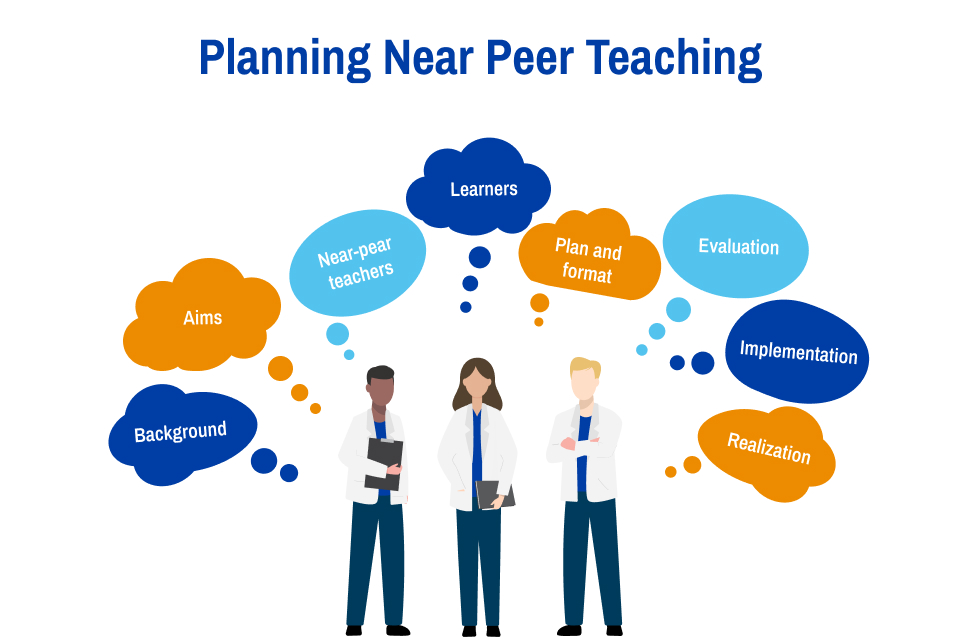Near-Peer Teaching in Medical Education
06/01/2024
Near-peer teaching is defined as a learner one or more years senior who teaches a junior learner in the same phase of training. Examples include a fourth-year medical student acting as student chief for rising third-year medical students or senior residents leading case report conferences for interns. Near-peer teaching has been used widely from primary to higher education and increasingly in medical education. Near-peer teaching has long occurred informally without faculty involvement. However, it has also been formally incorporated into basic science and clinical skills courses in undergraduate medical education as it is thought to benefit both peer teachers and learners.
Benefits of Near-Peer Teaching for Teachers and Learners
Following in the spirit of the proverb Docendo discimus, “by teaching we learn,” near-peer teaching is thought to increase learning for near-peer teachers. This may be through reengagement with the curriculum, enhanced motivation, deeper processing of information and retrieval of knowledge from memory through teaching. In addition to learning course content, near-peer teaching may also help train leadership skills and instill confidence in learners, and prepare learners for teaching in residency and careers as future physicians, educating patients, families and communities. Near-peer teaching can be effective for learners, and previous work has documented similar learning outcomes among near-peer and faculty teachers during problem-based learning and clinical skills sessions.
While near-peer teachers are not content experts, they have cognitive congruence with learners. Because they share a similar knowledge base, near-peer teachers are able to more easily put themselves in the learners’ shoes as compared to content experts; they can share approaches they used as learners to help master concepts, anticipate learners’ pitfalls and difficulties and avoid overwhelming learners with excess information. Near-peer teachers can also leverage social congruence with learners, as they occupy a similar social role in the hierarchy of medicine. This allows near-peer teachers to more easily promote a comfortable and safe learning environment that supports the exchange of ideas. Additionally, near-peers can act as role models, help learners navigate the hidden curriculum of medical education, and give learners confidence that if the near-peer succeeded, they can as well.
Planning Near-Peer Teaching
To incorporate near-peer teaching into a curriculum, use a planning and implementation framework to design your curriculum. Take the following questions into consideration:
- Background: Is near-peer teaching currently being used in the curriculum? Why should near-peer teaching be considered as part of this curriculum? Who will lead curriculum development and implementation?
- Aims: What are the aims and objectives of the curriculum for near-peer teachers, learners and the institution?
- Near-peer teachers: Who will serve as the near-peer teachers? Will there be any prerequisites or qualifications, such as a threshold of prior course performance? How will near-peer teachers be recruited? What training and preparation will they need and how will that occur?
- Learners: Who are your learners and what is their prior knowledge and experience? Will the session(s) be optional or required? How will they be advertised? What information and preparations will they need before the session(s)?
- Logistics: What is the format of the session? Where and when will it occur? What resources will be required?
- Evaluation: What feedback will be collected and for what purpose? How will the curriculum be evaluated? Will evaluation be conducted for research purposes in addition to quality improvement? If so, what are the hypotheses and how will they be tested?
- Implementation: Who are the stakeholders? What are staff time and funding needs? How might the project be received, developed and grown over time?
- Realization: What are potential bumps in the road or barriers to success? What are the key time points going forward? What are the actionable next steps and who is responsible for each?
Recruitment, Training, and Evaluation of Near-Peer Teachers
Now that you have planned your near-peer program, here are some additional considerations with regard to recruiting, training and evaluating near-peer teachers:
- Have learners and faculty co-lead near-peer teaching initiatives, to increase learner buy-in while also allowing the initiative to be sustainable as learners matriculate and graduate. Promote longitudinal relationships with faculty and invite near-peer teachers to faculty development and course planning when possible so they can feel a part of the team.
- Consider making near-peer teaching voluntary in order to ensure that participants are intrinsically motivated and interested. It may be helpful to offer incentives for near-peer teachers such as elective credit or financial compensation, especially depending on the time burden and workload required.
- Training for near-peer teachers should cover basic teaching principles, giving feedback, specific content as needed, and common classroom scenarios and how to address them. It is important that near-peer teachers understand their role, that they are not expected to be content experts, and that it is okay to admit when they do not know something so they can model curiosity and self-directed learning.
- Consider what the deliverable is for near-peer teachers. For example: are they running a session, creating questions, or writing a reflection. How will they get feedback for it?
- Be thoughtful and purposeful with the role of faculty in near-peer teaching sessions. Minimizing the presence of faculty is one strategy that can be used to promote a safe and learner-centered environment, especially if learners may perceive faculty to be evaluators.
- Avoid involvement of near-peers in summative evaluation of learners, be clear with learners about the role of near-peers regarding assessment and grading, and promote near-peer and learner interaction during near-peer teaching sessions.
Near-peer teaching can be used to foster learning at multiple levels, including to develop professional skills and enhance content understanding for near-peer teachers and to create a safe and supportive environment for junior learners. There are many considerations when employing near-peer teaching. Involving learners in leadership, supporting near-peer teachers in their work, and promoting a learner centered approach can help make a successful near-peer teaching initiative.

Karen “Ren” Ernst, M.D., is a 2024 alumna of the Saint Louis University School of Medicine. She is an incoming PGY-1 resident in pediatrics at the University of Nebraska Medical Center. Ernst's areas of professional interest include near-peer teaching and health systems science. Ernst can be found on LinkedIn or contacted via email.
